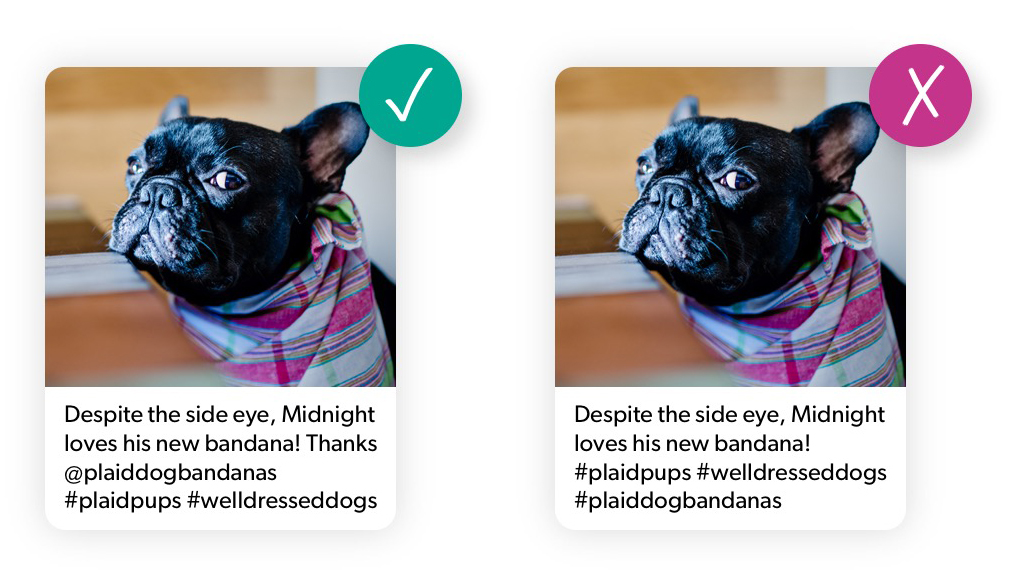August 29, 2018
Instagram, launched in 2010, has grown from 1 million users in December 2010 to over 1 billion monthly active users today. It’s no surprise that as consumer use of Instagram has grown, so has business use. Brands joined the conversation on Instagram to engage their customers, expand their reach, and tell their brand story through visual content. Today, thanks to numerous feature innovations since their inception, Instagram now also serves as a sales channel where brands can showcase products, run advertising campaigns, and drive conversion.
The rise of visual consumer-generated content
As social media platforms evolved, marketing evolved with it. Brands realized that their customers were talking about them on social media — sharing feedback, recommendations, and photos. Recommendations for products, services, or experiences that might have been in shared in person were now being shared on social media. With handles, hashtags, and location tags, it has become easy for brands to find these conversations, listen in, and engage with consumers.
Social media enables word-of-mouth conversation to travel at lightning speed. When someone, whether it is an average Joe customer or a high-profile influencer, posts about a business on social media, the impact can be immediate and far reaching. As consumers, we like to see what people around us like, do, and buy. The smartest brands realized this and began weaving photos and videos from customers (otherwise known as visual consumer-generated content) into their marketing mix — on social media, on product pages, in shoppable galleries on their website, and even in email marketing and in store.
This strategy around visual consumer-generated content (CGC) is paying off. Last year, across our network of 6,000+ brand and retailer websites, visual CGC saw a 55% year-over-year increase in conversion lift and had the highest revenue per visitor (RPV) lift of all consumer content.
The intersection of visual CGC and consumer privacy
To be able to use consumer photos and videos in their marketing, brands should ask the permission of the individual who produced the content to ensure they are comfortable with their content being shared broadly. Historically, brands have used #hashtags, mentions of their handle, and tagged photos to find the content their consumers are posting on social media. Using these identifiers, brands can then reach out to users by commenting on the original post and requesting permission to use their photo or video. To make these requests at scale and organize the sourced content, brands leverage technology, like our Curations platform, to automate this process through Instagram’s API.
Due to the recent scrutiny of social media platforms and their handling of consumer data, Instagram made some sudden changes to their API functionality earlier this year, in an effort to better protect its users security and privacy. As Instagram changes their standards, we have evolved to meet these requirements and have helped our customers evolve their visual CGC strategy accordingly.
Instagram Graph API Updates
January 30, 2018: Instagram Graph API launches and Instagram API platform deprecation
In early 2018, Instagram announced the launch of their new Graph API and scheduled deprecation of the former API, preparing technology providers that plug into their former API to begin coding for the new platform by July 31st.
April 4, 2018: Instagram unexpectedly shuts down old platform API, originally scheduled for July 31st deprecation
Without warning, Instagram shut down their old platform API four months early, effectively disabling the methods used by third party developers, including Bazaarvoice, to identify and collect photos and videos from users. Third party applications must now meet new standards, build integration for the new Graph API, and reapply for API access.
Solving for visual content collection from Instagram
What does this mean for Bazaarvoice and our customers who collect visual content from Instagram? As with anything in the world of social media and e-commerce, we evolve. Our Curations engineering team has been heads down coding up our integration with the Instagram Graph API and developing solutions for the changing requirements. As of late August, we are fully integrated with the Instagram Graph API and ability to send automated author permissions on Instagram was restored at that time.
While automated author permissions are available again through our Curations platform, Instagram now limits which content can be automatically commented on. Instagram previously allowed for auto author permissions using hashtags, user tags, and mentions of a brand username. With the new Graph API, brands can only comment and request author permissions on content where their handle has been explicitly mentioned (with an @ symbol) in the caption. In simple terms, @ mentions are the new hashtag.
Brands focused on visual content collection have historically run marketing campaigns to engage their audience with a hashtag call to action when posting photos and videos. Given the new requirements, brands should promote mentions of their Instagram username, in addition to the campaign specific hashtag.

Brands should be aware that while the amount of collected content may decrease, your approval rating and the quality of your content is likely to improve. Why? By mentioning brands directly in a username mention, Instagram users are actively inviting the brand to the conversation. These users are not only more likely to approve use permission, they are more likely to be loyalists, understand your brand tone and voice, and be better aligned with your visual content standards.
The graph API update is far from the first major change that Instagram has implemented to better serve its users, and it won’t be the last. As the platform, and social media as a whole, continues to change and advance, we will do the same and will help our customers to navigate the future of social commerce.





